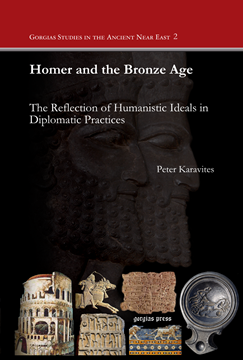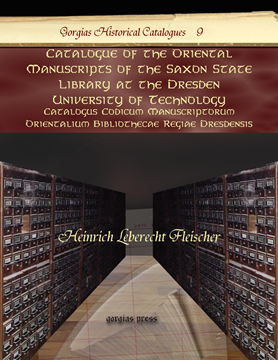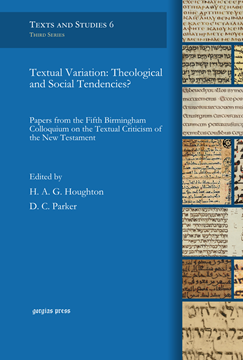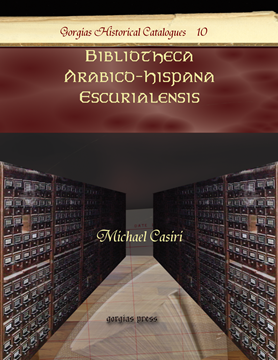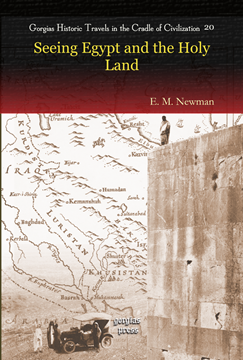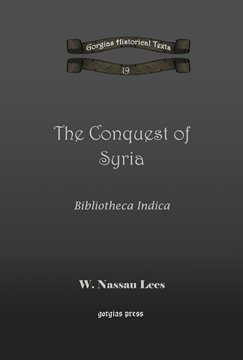Homer and the Bronze Age
The Reflection of Humanistic Ideals in Diplomatic Practices
Series: Gorgias Studies in the Ancient Near East 2
ISBN: 978-1-59333-985-2
Peter Karavites presents a revisionist overview of Homeric scholarship, whose purpose is to bridge the gap between the “positivist” and “negativist” theories dominant in the greater part of the twentieth century. His investigation derives new insights from Homer’s text and solves the age old question of the relationship between Homer and the Mycenaean age.
$148.00 (USD) $88.80 (USD)
Catalogue of the Oriental Manuscripts of the Saxon State Library at the Dresden University of Techno
Catalogus Codicum Manuscriptorum Orientalium Bibliothecae Regiae Dresdensis
Series: Kiraz Historical Catalogues Archive 9
ISBN: 978-1-59333-904-3
This historic catalogue documents the oriental manuscripts of what is now the Saxon State Library at the Dresden University of Technology. Formerly the Royal Library of Dresden, this repository houses numerous manuscripts from antiquity. Catalogued before the tragic bombing of Dresden during WWII, this historic record, written in Latin, briefly describes the nearly 600 documents in the collections of Dresden and Guelferbytan at that time. Valued more as a historical memento, this catalogue provides a sense of importance of the manuscripts housed in the library of the early 19th century capital of Saxony. Adding to the utility of his register are the indices to the codices included with the collection.
$123.00 (USD) $73.80 (USD)
Theological and Social Tendencies?
Papers from the Fifth Birmingham Colloquium on the Textual Criticism of the New Testament
Edited by H. A. G. Houghton & David C. Parker
Series: Texts and Studies (Third Series) 6
ISBN: 978-1-59333-789-6
Did scribes intentionally change the text of the New Testament? This book argues they did not and disputes the claims that variant readings are theologically motivated. Using evidence gathered from some of the earliest surviving biblical manuscripts these essays reconstruct the copying habits of scribes and explore the contexts in which they worked. Alongside these are studies of selected early Christian writings, which illustrate attitudes to and examples of textual change.
$135.00 (USD) $81.00 (USD)
Bibliotheca Arabico-Hispana Escurialensis
Series: Kiraz Historical Catalogues Archive 10
ISBN: 978-1-59333-908-1
Eager to preserve the Spanish and Arabic heritage, Miguel Casiri set out to catalogue the 1800 Arabic manuscripts in the Royal Monastery of San Lorenzo El Real, known generally by the title El Escorial. The resulting work was a monument of scholarship in the eighteenth century. Containing a number of quotes from Arabic sources on history, geographical and historical manuscripts, full text of both volumes, indicies, and subject divisions, this edition, part of Gorgias Historical Catalogues, serves as a historic and linguistic study, as well as a reference work.
$366.00 (USD) $219.60 (USD)
Seeing Egypt and the Holy Land
By E. M. Newman
Series: Kiraz Historic Travels Archive 20
ISBN: 978-1-59333-911-1
With the characteristic compelling photographs that accompany his work, E. M. Newman here presents his unique outlook on Egypt and the Holy Land. Written with the competence of a professional travel writer, Newman takes the reader through his arrival in Egypt by ship and on a virtual tour of the noted wonders of that land. His impressions of Egypt, Palestine, the Arabian Desert and Sinai are all dutifully recorded. Finishing up with the accounts of his main New Testament sites, Nazareth, the Jordan River, Bethlehem, and Jerusalem, this travelogue contains a wealth of impressions and memories. Illustrated with over 300 photographs, this volume gives a visually descriptive tour of these ancient lands.
$185.00 (USD) $111.00 (USD)
The Conquest of Syria
Bibliotheca Indica
Series: Kiraz Chronicles Archive 19
ISBN: 978-1-59333-913-5
A representative of the Arabic genre known as “futuh reports,” The Conquest of Syria remains an important historical source although it is now recognized not to be the work of Abu Abdullah Muhammad Ibn Omar Ibn Waqid al-Aslami (called al-Waqidi). This Arabic document, part history, part romantic reconstruction of the past, is one of the main sources narrating the Muslim conquest of Syria. A window into the world of early Muslim self-perception, these documents are a valuable historical source in the sense of being period pieces. Here the Arabic text is presented along with the partial notes and comments of W. Nassau Lees, a noted writer on Eastern culture.
$289.00 (USD) $173.40 (USD)
